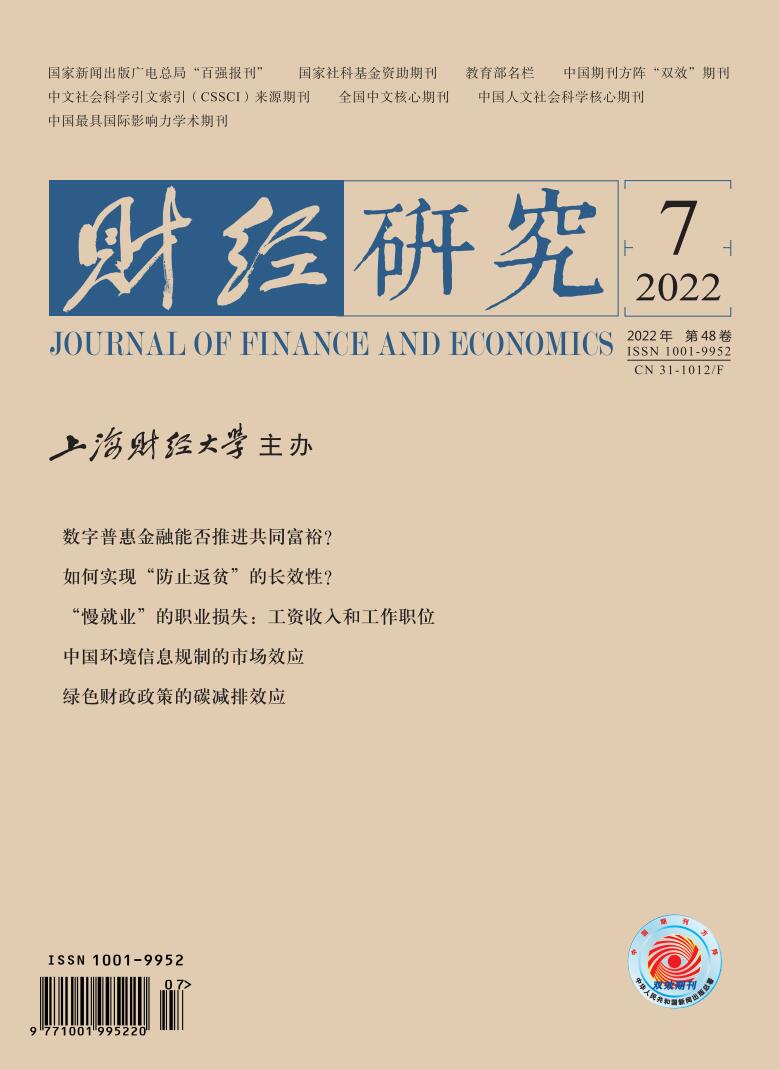作为经济载体的企业如何在谋求自身发展的同时保护好生态环境是转型时期企业面临的重要问题,亦是学术界关注的重要议题。文章以2010—2019年的中国上市企业为研究样本,考察了企业绿色绩效的行业落差对环保投资的影响,发现:第一,当绿色绩效低于行业期望水平时,企业会增加环保投资,这一结论在进行了选择性偏差调整、PSM检验以及不同样本的检验后依然稳健。第二,与非重污染企业相比,绿色绩效落差对企业环保投资的影响作用在重污染企业中更强;当企业面临较强的破产压力时,绿色绩效落差对企业环保投资的制约作用则会被削弱;行业竞争程度越高,绿色绩效落差对企业环保投资的促进作用越强。进一步研究发现,绿色绩效落差对企业环保投资的影响作用在国有企业中更显著;而破产压力和行业竞争程度对绿色绩效落差和企业环保投资的调节效应则在民营企业中更加显著;并且,在《环境空气质量标准(2012)》颁布后,绿色绩效落差对企业环保投资的影响作用更强。文章的研究为理解企业环保投资提供了新的视角,具有一定的理论和实践意义。
企业绿色绩效的行业落差与环保投资
摘要
参考文献
3 贾兴平,刘益. 外部环境、内部资源与企业社会责任[J]. 南开管理评论,2014,(6):13−18. DOI:10.3969/j.issn.1008-3448.2014.06.003
6 刘柏,卢家锐. “顺应潮流”还是“投机取巧”:企业社会责任的传染机制研究[J]. 南开管理评论,2018,(4):182−194. DOI:10.3969/j.issn.1008-3448.2018.04.017
7 马骏,朱斌,何轩. 家族企业何以成为更积极的绿色创新推动者?−基于社会情感财富和制度合法性的解释[J]. 管理科学学报,2020,(9):31−60. DOI:10.3969/j.issn.1007-9807.2020.09.003
9 王建明. 环境信息披露、行业差异和外部制度压力相关性研究−来自我国沪市上市公司环境信息披露的经验证据[J]. 会计研究,2008,(6):54−62. DOI:10.3969/j.issn.1003-2886.2008.06.006
12 Audia P G, Greve H R. Less likely to fail: Low performance, firm size, and factory expansion in the shipbuilding industry[J]. Management Science,2006,52(1): 83−94. DOI:10.1287/mnsc.1050.0446
13 Barney J. Firm resources and sustained competitive advantage[J]. Journal of Management,1991,17(1): 99−120. DOI:10.1177/014920639101700108
14 Berrone P, Fosfuri A, Gelabert L, et al. Necessity as the mother of ‘green’ inventions: Institutional pressures and environ- mental innovations[J]. Strategic Management Journal,2013,34(8): 891−909. DOI:10.1002/smj.2041
16 Chen W R. Determinants of firms' backward- and forward-looking R&D search behavior[J]. Organization Science,2008,19(4): 609−622. DOI:10.1287/orsc.1070.0320
17 Chen W Y, Zhou G G, Zhu X D. CEO tenure and corporate social responsibility performance[J]. Journal of Business Research,2019,95: 292−302. DOI:10.1016/j.jbusres.2018.08.018
18 Chirico F, Gómez-Mejia L R, Hellerstedt K, et al. To merge, sell, or liquidate? Socioemotional wealth, family control, and the choice of business exit[J]. Journal of Management,2020,46(8): 1342−1379. DOI:10.1177/0149206318818723
19 Cyert R M, March J G. A behavioral theory of the firm[M]. Upper Saddle River: Prentice-Hall, 1963.
20 Delmas M A, Toffel M W. Organizational responses to environmental demands: Opening the black box[J]. Strategic Management Journal,2008,29(10): 1027−1055. DOI:10.1002/smj.701
21 DiMaggio P J, Powell W W. The iron cage revisited: Institutional isomorphism and collective rationality in organizational fields[J]. American Sociological Review,1983,48(2): 147−160. DOI:10.2307/2095101
24 Fombrun C J. A world of reputation research, analysis and thinking — building corporate reputation through CSR initiatives: Evolving standards[J]. Corporate Reputation Review,2005,8(1): 7−12. DOI:10.1057/palgrave.crr.1540235
26 Haunschild P R, Miner A S. Modes of interorganizational imitation: The effects of outcome salience and uncertainty[J]. Administrative Science Quarterly,1997,42(3): 472−500. DOI:10.2307/2393735
27 Haveman H A, Jia N, Shi J, et al. The dynamics of political embeddedness in China[J]. Administrative Science Quarterly,2017,62(1): 67−104. DOI:10.1177/0001839216657311
28 Hillman A J, Keim G D. Shareholder value, stakeholder management, and social issues: What's the bottom line?[J]. Strategic Management Journal,2001,22(2): 125−139. DOI:10.1002/1097-0266(200101)22:2<125::AID-SMJ150>3.0.CO;2-H
29 Jeong Y C, Kim T Y. Between legitimacy and efficiency: An institutional theory of corporate giving[J]. Academy of Management Journal,2019,62(5): 1583−1608. DOI:10.5465/amj.2016.0575
30 Kim E H, Lyon T P. Greenwash vs. Brownwash: Exaggeration and undue modesty in corporate sustainability disclo- sure[J]. Organization Science,2015,26(3): 705−723. DOI:10.1287/orsc.2014.0949
31 Koh P S, Qian C L, Wang H L. Firm litigation risk and the insurance value of corporate social performance[J]. Strategic Management Journal,2014,35(10): 1464−1482. DOI:10.1002/smj.2171
32 Lai C S, Chiu C J, Yang C F, et al. The effects of corporate social responsibility on brand performance: The mediating effect of industrial brand equity and corporate reputation[J]. Journal of Business Ethics,2010,95(3): 457−469. DOI:10.1007/s10551-010-0433-1
33 Leary M T, Roberts M R. Do peer firms affect corporate financial policy?[J]. The Journal of Finance,2014,69(1): 139−178. DOI:10.1111/jofi.12094
34 Li J, Zhou C H, Zajac E J. Control, collaboration, and productivity in international joint ventures: Theory and evidence[J]. Strategic Management Journal,2009,30(8): 865−884. DOI:10.1002/smj.771
35 March J G, Shapira Z. Managerial perspectives on risk and risk taking[J]. Management Science,1987,33(11): 1404−1418. DOI:10.1287/mnsc.33.11.1404
36 Marquis C, Qian C L. Corporate social responsibility reporting in China: Symbol or substance?[J]. Organization Science,2014,25(1): 127−148. DOI:10.1287/orsc.2013.0837
37 McWilliams A, Siegel D. Corporate social responsibility: A theory of the firm perspective[J]. Academy of Management Review,2001,26(1): 117−127. DOI:10.5465/amr.2001.4011987
38 McWilliams A, Siegel D S, Wright P M. Corporate social responsibility: Strategic implications[J]. Journal of Management Studies,2006,43(1): 1−18. DOI:10.1111/j.1467-6486.2006.00580.x
39 Minor D, Morgan J. CSR as reputation insurance: Primum non nocere[J]. California Management Review,2011,53(3): 40−59. DOI:10.1525/cmr.2011.53.3.40
40 Nason R S, Bacq S, Gras D. A behavioral theory of social performance: Social identity and stakeholder expectations[J]. Academy of Management Review,2018,43(2): 259−283. DOI:10.5465/amr.2015.0081
41 Navis C, Glynn M A. How new market categories emerge: Temporal dynamics of legitimacy, identity, and entrepre- neurship in satellite radio, 1990-2005[J]. Administrative Science Quarterly,2010,55(3): 439−471. DOI:10.2189/asqu.2010.55.3.439
42 Paruchuri S, Misangyi V F. Investor perceptions of financial misconduct: The heterogeneous contamination of bystander firms[J]. Academy of Management Journal,2015,58(1): 169−194. DOI:10.5465/amj.2012.0704
43 Rudy B C, Johnson A F. Performance, aspirations, and market versus nonmarket investment[J]. Journal of Management,2016,42(4): 936−959. DOI:10.1177/0149206313503017
44 Shinkle G A. Organizational aspirations, reference points, and goals: Building on the past and aiming for the future[J]. Journal of Management,2012,38(1): 415−455. DOI:10.1177/0149206311419856
45 Surroca J, Tribó J A, Waddock S. Corporate responsibility and financial performance: The role of intangible resources[J]. Strategic Management Journal,2010,31(5): 463−490. DOI:10.1002/smj.820
47 Wang R X, Wijen F, Heugens P P M A R. Government's green grip: Multifaceted state influence on corporate environmental actions in China[J]. Strategic Management Journal,2018,39(2): 403−428. DOI:10.1002/smj.2714
48 Xu D A, Zhou K Z, Du F. Deviant versus aspirational risk taking: The effects of performance feedback on bribery expenditure and R&D intensity[J]. Academy of Management Journal,2019,62(4): 1226−1251. DOI:10.5465/amj.2016.0749
49 Zhang Y L, Wang H L, Zhou X Y. Dare to be different? Conformity versus differentiation in corporate social activities of Chinese firms and market responses[J]. Academy of Management Journal,2020,63(3): 717−742. DOI:10.5465/amj.2017.0412
引用本文
朱丽娜, 张正元, 高皓. 企业绿色绩效的行业落差与环保投资[J]. 财经研究, 2022, 48(7): 94-108.
导出参考文献,格式为:





 5959
5959  5719
5719

